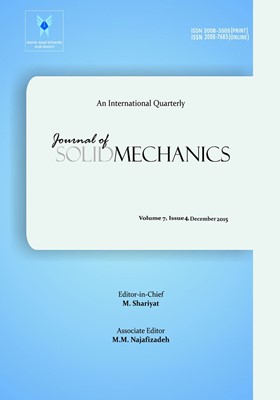Analysis of Axisymmetric Extrusion Process through Dies of any Shape with General Shear Boundaries
محورهای موضوعی : Engineering
1 - Mechanical Engineering Department, Razi University
2 - Faculty of Mechanical Engineering , Shahid Rajaee Training University
کلید واژه: Upper bound method, Velocity field, Axisymmetric extrusion,
چکیده مقاله :
In this paper, a generalized expression for the flow field in axisymmetric extrusion process is suggested to be valid for any dies and the boundary shapes of the plastic deformation zone. The general power terms are derived and the extrusion force is calculated by applying upper bound technique for a streamlined die shape and exponential functions for shear boundaries. It is shown that assuming exponential boundaries for deformation zone yields a die shape with smaller extrusion force than that of by assuming spherical shape boundaries is in agreement with the results obtained by the finite element method.
[1] Avitzur B., 1963, Analysis of wire drawing and extrusion through conical dies of small cone angle, Transactions of the ASME, Journal of Engineering for Industry 85: 89-96.
[2] Avitzur B., 1964, Analysis of wire drawing and extrusion through conical dies of large cone angle, Transactions of the ASME, Journal of Engineering for Industry 86: 305-314.
[3] Avitzur B., 1966, Flow characteristics through conical converging dies, Transactions of the ASME, Journal of Engineering for Industry 88: 410-420.
[4] Avitzur B., 1967, Strain-hardening and strain-rate effects in plastic flow through conical converging dies, Transactions of the ASME, Journal of Engineering for Industry 89: 556-562.
[5] Zimerman Z., Avitzur B., 1970, Metal flow through conical converging dies-a lower upper bound approach using generalized boundaries of the plastic zone, Transactions of the ASME, Journal of Engineering for Industry 92: 119-129.
[6] Chen C. T., Ling F. F., 1968, Upper bound solutions to axisymmetric extrusion problems, International Journal of Mechanical Sciences 10: 863-879.
[7] Nagpal V., 1974, General kinematically admissible velocity fields for some axisymmetric metal forming problems, Transactions of the ASME, Journal of Engineering for Industry 96: 1197-1201.
[8] Yang DY D.Y., Han CH C.H., Lee B.C., 1985, The use of generalised deformation boundaries for the analysis of axisymmetric extrusion through curved dies, International Journal of Mechanical Sciences 27: 653-663.
[9] Osakada K., Niimi Y., 1975, A study on radial flow field for extrusion through conical dies, International Journal of Mechanical Sciences 17: 241-254.
[10] Yang D. Y., Han C. H., 1987, A new formulation of generalized velocity field for axisymmetric forward extrusion through arbitrarily curved dies, Transactions of the ASME, Journal of Engineering for Industry 109: 161-168.
[11] Peng D. S., 1990, An upper bound analysis of the geometric shape of the deformation zone in rod extrusion, Journal of Materials Processing Technology 21: 303-311.
[12] Gordon W. A., Van Tyne C. J., Sriram S., 2002, Extrusion through spherical dies—an upper bound analysis, Transactions of the ASME,Journal of Manufacturing Science and Engineering 124: 92-97.
[13] Gordon W. A., Van Tyne C. J., Moon Y. H., 2007, Axisymmetric extrusion through adaptable dies—Part 1: Flexible velocity fields and power terms, International Journal of Mechanical Sciences 49: 86-95.
[14] Gordon W. A., Van Tyne C. J., Moon Y. H., 2007, Axisymmetric extrusion through adaptable dies—Part 2: Comparison of velocity fields, International Journal of Mechanical Sciences 49: 96-103.
[15] Gordon W. A., Van Tyne C. J., Moon Y. H., 2007, Axisymmetric extrusion through adaptable dies—Part 3: Minimum pressure streamlined die shapes, International Journal of Mechanical Sciences 49: 104-115.
[16] Avitzur B., 1968, Metal Forming: Processes and Analysis, New York, NY: McGraw-Hill.


